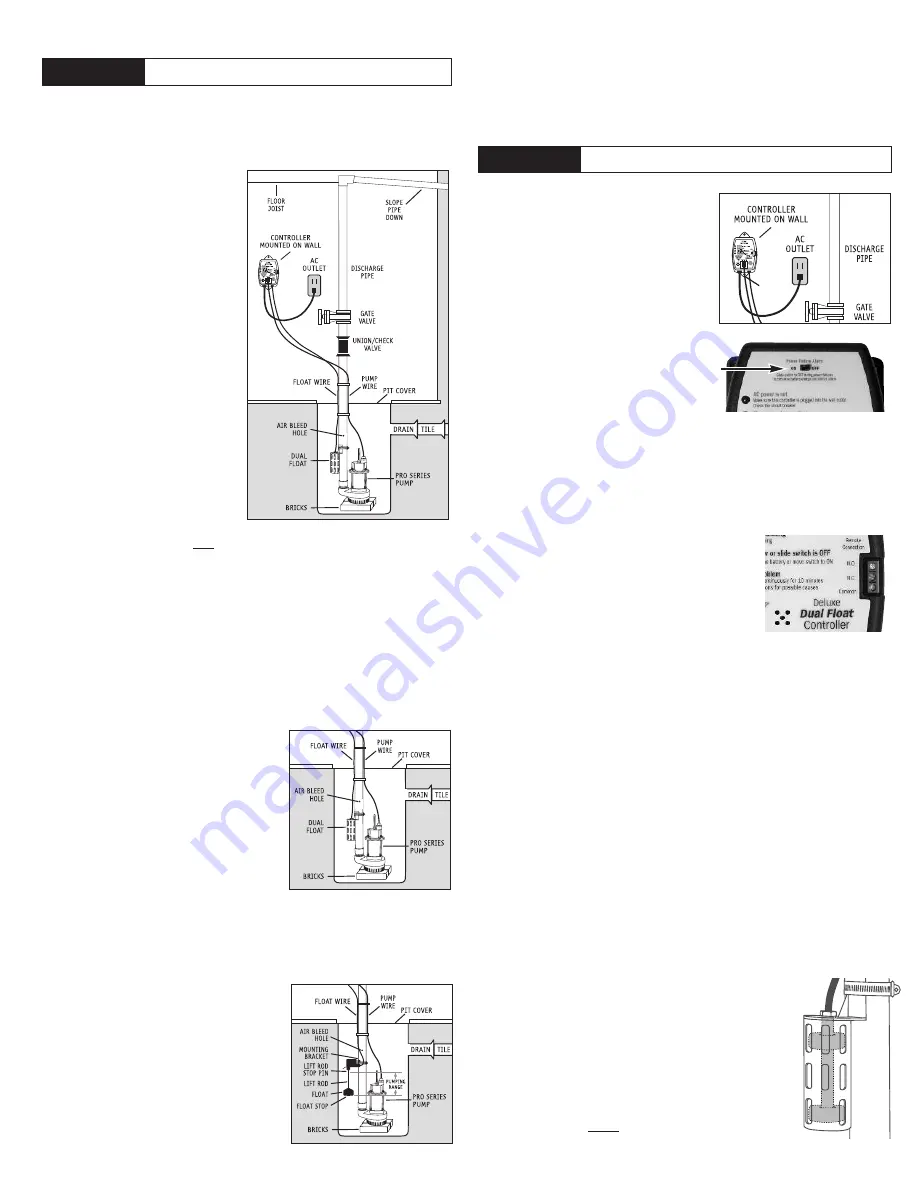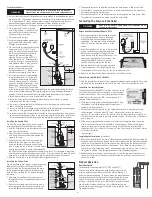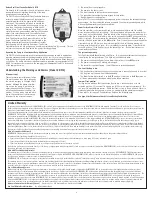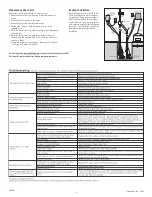
Installing the Pump
1. Use a pit that conforms to all local codes and is large enough to accommodate the pump
and float switch. The minimum requirements for pumps with the double float assembly are
10” in diameter and 14” deep. However, larger sump pits are preferred, since they will
extend the discharge cycle and reduce the number of times the pump turns on.
2. Clean the pit of all debris. The pump’s intake screen must be kept clear.
3. The pump should not be set directly
onto a clay, earthen, or sand base. You
may install bricks or blocks under the
pump to provide a solid base.
4. The pump should be level.
5. Install discharge plumbing according to
local, regional and state codes. Rigid
PVC pipe is recommended.
6. The sizes of the discharge outlets on the
pumps vary from 1
1
⁄
2
“ to 2“. Try to
match the size of the discharge pipe to
the size of the outlet on the pump to
maintain the optimum pumping
capacity. If you are using a PHCC Pro
Series pump with a 2“ discharge outlet
to replace a pump in a system that has
been plumbed with 1
1
⁄
2
“ pipe, you may
use the adapter included with the
system to reduce the size of the
discharge outlet to 1
1
⁄
2
“. However, this
will reduce the capacity of the pump.
7. An in-line check valve is recommended
to prevent back-flow. This check valve
is mandatory when sharing a discharge
line with another pump (i.e. a back-up
pump or a second primary pump).
Note:
When using a check valve, an air bleed
hole of
1
⁄
8
“
(3.2mm) needs to be drilled
in the discharge pipe. The hole must be drilled above the water line but below the check
valve. A small stream of water will escape through this air bleed hole when the pump is
running, so the hole should be drilled on an angle toward the bottom of the sump pit.
8. Install a gate valve or ball valve as required by any codes.
9. Secure the power cord to the discharge pipe with wire ties or clamps to prevent
interference with the float assembly.
10. A pit cover is recommended for all installations as a safety measure, and to prevent
debris from falling into the pit.
11. A cover is required in all sewage pump installations with gas-tight seals to contain gases
and odors. A vent pipe should be added in any sewage installation.
12. In instances where the discharge line is exposed to freezing temperatures, the pipe must
be positioned in a downward slope so any remaining water will drain away. Failure to do
this will prevent water from exiting the pit and damage the pump if the line freezes.
Installing the Double Float
The PHCC Pro Series double float switch is easy to
install by using the enclosed metal hose clamp.
1. Hold the float switch to the discharge pipe so the
cage is below the bracket.
2. Secure the float to the pipe with the enclosed
hose clamp, but do not completely tighten the
clamp at this time.
3. Position the float switch to a level where the
bottom of the float cage is no lower than 3“
above the bottom of the pump and no higher
than 1“ below the top of the pit. To avoid debris
pouring into the float, it should be positioned on
the side of the discharge pipe opposite the drain tile.
Note: It is important to mount the
float below the drain tile that empties into the pit. Mounting it above the drain tile would
allow water to fill the drain tile before the pump is activated to pump out the water.
4. Once the float switch is in the desired position, tighten the clamp.
Installing the Vertical Float
The vertical float switch contains a single large float.
Water will lift the float to the top of the lift rod
which will raise the lift rod and activate the pump.
As the pump evacuates the water from the pit the
float will drop, lowering the lift rod and turning off
the pump.
1. Fully open the metal hose clamp and insert it
through the slots in the mounting bracket of the
float switch.
2. Place the hose clamp over the discharge pipe so
that the gripping tabs are against the pipe and
select the desired activation level of the pump.
3. The pumping range can be adjusted by moving the float stop up or down the lift rod.
4. To avoid debris from pouring onto the float, it should be positioned on the side of the
discharge pipe opposite the drain tile.
5. Once the float switch is in the desired position, securely tighten the hose clamp. Note:
The cable from the switch must remain outside the hose clamp.
Connecting the Pump and Controller
Deluxe Dual Float Controller Model # DFC2
1. Mount the controller to the foundation, drywall
or a stud through the 2 holes on the cabinet
using the proper mounting hardware for the
application. The controller should be mounted
at least 4’ from the floor and within 4’ of the
outlet.
2. Open the plastic door on the top of the unit and
using a small flat head screwdriver adjust the
dial to select the number of seconds that the
pump will run after the bottom float drops. The
timer can be adjusted from 5-45 seconds. The
manufacturer default is about 10 seconds.
Install a 9V battery and replace the door.
3. Plug the control box into a properly grounded,
3-prong receptacle. Then, plug the pump into
the receptacle on the control box. Do not use an extension cord.
4. Make sure the Power Failure Alarm slide switch is in the ON position.
Vertical Float Switch Model # 1020012
1. Plug the vertical float switch cord into a properly grounded 3-prong receptacle. Then, plug
the pump into the receptacle on the float switch cord. Do not use an extension cord.
Connecting to a Security System
The Deluxe Controller (Model DFC2) includes a terminal on the
right side of the control box to connect to a security system
or other alarm devices. There are (3) three positions for wire
connections on this terminal: N.O. – normally open, N.C. –
normally closed, and Common.
1. Check your security system to determine whether an open
(no contact) or closed (making contact) connection is
needed to activate the alarm.
2. The security system will provide (2) two connection terminals to extend wires to the
control terminal. Strip two wires 1/4“ each. Connect either wire to the common
terminal. To secure the wire into the terminal, insert the exposed wire into the hole on
the side of the terminal next to the screw marked common. Turn the screw a few turns to
lock-in the wire.
3. If the security system requires a closing of a contact to activate the alarm, secure the
other wire into the terminal hole labeled N.O. (normally open). If the security system
requires an opening of a contact, secure the wire into the terminal hole labeled N.C.
(normally closed).
Note: Only the “AC power out” and ‘Float raised for 10 minutes” alarms
will activate the remote
terminal signal.
Completing the Installation
(all models)
1. After the initial installation, be sure to check the pump operation by filling the sump with
water and observing the pump through one full cycle. When using the dual float the pump
should run for 10 seconds after the lower float drops. When using the tethered float the
pump should shut off when the float is tilted down.
Note: When the pump activates, it
should have a “normal pumping” sound. Any abnormal sound, vibration, or lack of output is
the signal of a problem. Stop the pump and refer to the troubleshooting guide.
2. Replace the pit cover making sure not to pinch or crimp the pump wire with the cover.
The pit cover either has a ‘hole punch’ that will allow the cord to be passed through or
one can be drilled.
Product Operation
Dual Float Switch
(included with controller models DFC1, DFC1.5 and DFC2)
The dual float switch contains two large floating rings enclosed
within a protective cage. Water will lift the bottom float by a
1
⁄
4
“,
which will activate the pump. If for any reason the lower float does
not activate the pump, the water will rise and activate the second
switch. As the pump evacuates the water from the pit the floats
will drop. The pump will run for an additional 10 seconds to extend
the cycle after the lower float drops.
Note: When mounting the
float switch, position the bottom of the cage at the height you want
the pump to activate.
WARNING
WARNING
This installation must be in accordance with the National
Electric Code and all applicable local codes and ordinances.
Make sure the outlet is single phase, 115V and 60HZ for all
the pump installations.
PUMP
WIRE
2







